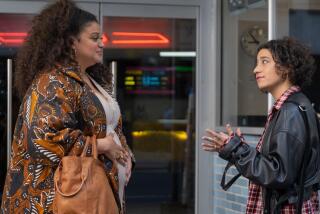MOVIE REVIEWS : ‘Three Men and a Baby’ Pampers the Senses
As W. C. Fields might have cautioned us, no one steals a movie scene like a well-lit baby. And, in “Three Men and a Baby” (citywide), both the babies and the lighting are expert. Twins Lisa and Michelle Blair--jointly playing a infant left unexpectedly on the doorstep of three swinging New York bachelors--coo, bat their eyes, clap and soil their surroundings with eerie expertise. When either of them lies spread-eagled on a Pamper, forcing co-stars Tom Selleck, Steve Guttenberg and Ted Danson to cope, they charge up the whole movie.
The lighting coos too. In cinematographer Adam Greenberg’s hands, it’s a bright, creamy wash, spilling onto a paradisiacal bachelor penthouse that’s been crammed with high-tech toys and work tools, designed by Peter Larkin with what seems extravagantly pricey glee.
Real estate agents may go crazy over this movie. This glorioso, splendiferously jam-packed Manhattan pad has a weird view in which the Empire State Building seems telescoped right over Central Park. But, along with the babies and Selleck, it’s the prime attraction. Whenever dialogue bores you or a scene seems obvious, or there are too many Pamper jokes, you can feast on the myriad details of Larkin’s set.
“Three Men and a Baby” is an Americanization of one of the biggest recent French box-office hits: Coline Serreau’s “Three Men and a Cradle.” Serreau’s movie was fairly frothy, and this one is frothier still.
Where before, much of the humor came from a woman’s amused reaction to the sudden maternal problems of three definitively anti-marriage bachelors, this adaptation--written and directed by men--is more coy, more cutesy-poo. But it has the likability of the first movie. The people who made it have carried over much of the original’s weightless, sweet-tempered flavor.
Both movies are post-Sexual Revolution sentimental comedies. They’re about big-city bachelors who lead wanton, promiscuous lives, suddenly forced to face the consequences of procreation: taking over a baby one of them has fathered. At first, diapering and feeding is Hell on Earth for these woman-chasing buddies; gradually it becomes a warm communal ritual they don’t want to lose.
In Serreau’s movie, the trio were 30ish Parisian playboys--airline pilot, ad man and cartoonist-- pooling their resources to share the lavish pied-a-terre, glaceed with apricot light that none of them singly could afford. In this version, the swing-pad houses a considerably more upscale threesome: architect Peter (Tom Selleck), comic-strip artist Michael (Steve Guttenberg) and actor Jack (Ted Danson). Despite their easy camaraderie, it’s hard to figure out why these three are living together--or why they never hire a nurse. Danson’s gypsy actor looks as if he could use help with the rent, but do a successful architect--who designs penthouses like this--and a nationally syndicated cartoonist need roomies?
Writers James Orr and Jim Cruikshank never really clear this up, and they’re not very good at the little banter and automatic in-jokes that men like this would share. The trio’s promiscuity has also been toned down for this PG version--and since there are fewer women traipsing through the place, the whole story takes on a vaguely gay tinge.
Any movie in which Steve Guttenberg plays the sensitive guy would seem to be in big, big trouble; it’s like casting Fred MacMurray as a heartbroken poet. But director Leonard Nimoy has the knack for relationships that the writers seem to lack. Under his hand, Guttenberg’s hangdog, wide-eyed takes bounce pleasantly off Danson’s stiff narcissism--though both of them are upstaged by Selleck.
Selleck seems to find his true movie metier here: The relaxed bachelor camaraderie almost echoes the tongue-in-cheek ambiance on “Magnum, P.I.” Along with Celeste Holm--who does a stylish turn as the baby’s grandmother--Selleck gives the film’s best performance. His soft-edged, less-is-more, Burt Reynolds-over-James Garner style works much better in this light character comedy than it might in one of the new psychologically minimalist, brutal action movies. Ironically, the one scene which doesn’t work--a showdown with heroin smugglers--seems to belong in a car crash-crazy ‘80s thriller.
Both “Three Men” and Diane Keaton’s “Baby Boom” seem responses to a current malaise: something deep in all those baby-boomers who have protracted their “young adulthood,” and sexual adventurism almost up to middle age, and now feel cheated. They yearn for what seems the comfortable continuity of their parents’ lives but feel past the point of achieving it.
“Three Men” strikes a funny chord. The audience seems to want to believe that these guys can be domesticated, but on another level, they don’t want the trio broken. They want bachelor fathers, domesticated swingers.
In this froth of contradictions, logic crumbles and we’re left with sun splashing through dream-Manhattan interiors, Selleck’s terrific slow-take consternation, Guttenberg’s frenzied touch with a diaper and Danson’s mirror-struck guilt shtick. But without the baby, of course, the three men would be lost on their own set.
‘THREE MEN AND A BABY’ A Touchstone Pictures/Silver Screen Partners III presentation of a Jean Francois Lepetit/Interscope Communications Inc. production. Producers Ted Field, Robert W. Cort. Director Leonard Nimoy. Script James Orr and Jim Cruikshank. Camera Adam Greenberg. Production design Peter Larkin. Editor Michael A. Stevenson. Music Marvin Hamlisch. With Tom Selleck, Steve Guttenberg, Ted Danson, Nancy Travis, Margaret Colin, Phillip Bosco, Celeste Holm, Derek De Lint.
Running time: 1 hour, 41 minutes.
MPAA rating: PG (parental guidance suggested; some material may not be suitable for children).
More to Read
Only good movies
Get the Indie Focus newsletter, Mark Olsen's weekly guide to the world of cinema.
You may occasionally receive promotional content from the Los Angeles Times.









